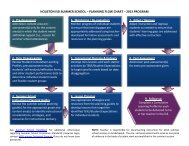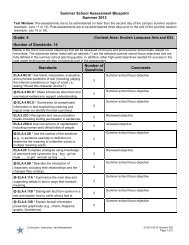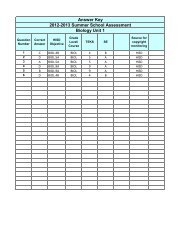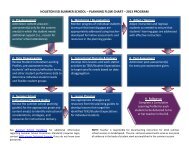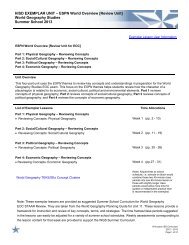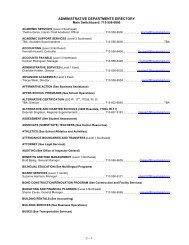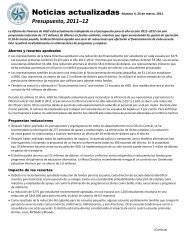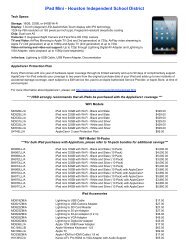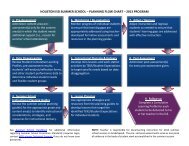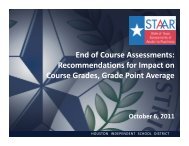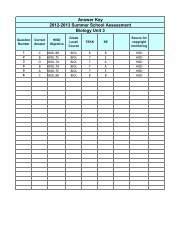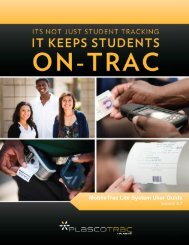SSK Unit 4.2 Planning Guide
SSK Unit 4.2 Planning Guide
SSK Unit 4.2 Planning Guide
- No tags were found...
You also want an ePaper? Increase the reach of your titles
YUMPU automatically turns print PDFs into web optimized ePapers that Google loves.
Instructional ConsiderationsHISD PLANNING GUIDEEnglish Language Arts Grade 7SUMMER SCHOOLStudents must be able to evaluate, interpret, and explain information in their own words. Using Dialectical Journalsgives students the opportunity to organize evidence from text, create commentary, and make inferences. Students needto draw on this skill in order to effectively write expository papers in this unit. See Dialectical Journal- NonfictionAnalysis in Instructional Strategies. Remind students to record all information in their Literacy Notebooks.(ELA.7.Fig19D)STAAR Connection- Creating assessment items that have the same or similar stems helps students prepare for theSTAAR exam. Although there are no released items for expository texts in 7 th grade, there are released items forELA.6.10A (Selection 2, Items 1-2). See Released STAAR Items in Assessment Connections. The Texas EducationAgency has provided a helpful resource page that can be accessed at the main TEA website.WritingPrerequisitesStudents should understand the writing process and how to use it to develop a piece of writing.Background Knowledge for TeacherHave students work in Writing Groups as a means to develop their expository essays. Students can share ideas,problems, solutions, and support one another’s efforts. Some students may require mini-lessons on appropriate groupbehavior and guidelines. See Writing Groups in Instructional Strategies.Use the 6+1 Traits of writing to discuss writing and writing improvement with your students. This provides acommon language for students and, through evaluation, creates powerful, effective writers.Formative Assessment- Introduce expository writing and share the guidelines and rubric with students early in thewriting process. Create an anchor chart of the requirements as a reference for students. See Formative Assessment-STAAR Expository Essay Rubric in Assessment Connections for the official STAAR Rubric. The rubric can be used todevelop mini-lessons and serves as a formative assessment. For student models and exemplars, see SpringBoardLevel 2 and Writing Coach Grade 7 in Resources.Continue to have students record their work in their Writer’s Notebooks. See ELA Best Practices MS inResources.A Teacher’s Writer’s Notebook is a powerful tool for teaching writing. Continue keeping a notebook as a means ofproviding samples of the writing process. Model each step of the writing process for students.Reiterate that expository writing utilizes various organizational patterns. Review the organizational patterns and remindstudents they are to choose an appropriate pattern for their expository essay. See Literature Grade 7 and WriteSmartDVD-ROM in Resources. (ELA.7.14C, ELA.7.17A.iii)Reiterate that regardless of the organizational pattern, all expository writing includes: Thesis Introduction Body paragraphs with topic sentences ConclusionRemind students that their essays must contain effective introductions and conclusions. Use mentor texts to providefurther examples as needed. See Lane’s The Reviser’s Toolbox and Culham’s 6+1 Traits of Writing: Grades 3 and Upin Resources. (ELA.7.14C, ELA.7.17A.i)Explain thesis statements, also called controlling ideas, and provide examples in mentor texts. To assist students increating their own thesis statements, have them ask themselves, “What do I want my audience to understand?” Reviewthe function of a thesis and provide examples in mentor texts. See Creating Effective Thesis Statements in InstructionalStrategies and the LEO- Thesis Statement website in Resources. (ELA.7.17A.ii) - English Language Proficiency Standards (ELPS) - Literacy Leads the Way Best Practices - Aligned to Upcoming State Readiness Standard- State Process Standard R - State Readiness Standard S - State Supporting Standard© Houston ISD Curriculum2012 – 2013Page 6 of 12




